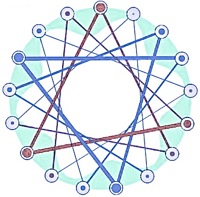Difference between revisions of "Harmonics"
(Created page with 'File:lighterstill.jpgright|frame A '''harmonic''' of a wave is a component frequency of the signal that is an [http://en.wi...') |
m (Text replacement - "http://" to "https://") |
||
| Line 1: | Line 1: | ||
[[File:lighterstill.jpg]][[File:Meshcon2harmonics._2.jpg|right|frame]] | [[File:lighterstill.jpg]][[File:Meshcon2harmonics._2.jpg|right|frame]] | ||
| − | A '''harmonic''' of a [[wave]] is a component [[frequency]] of the [[signal]] that is an [ | + | A '''harmonic''' of a [[wave]] is a component [[frequency]] of the [[signal]] that is an [https://en.wikipedia.org/wiki/Integer integer] multiple of the [https://en.wikipedia.org/wiki/Fundamental_frequency fundamental frequency], i.e. if the fundamental frequency is f, the harmonics have frequencies 2f, 3f, 4f, . . . etc. The harmonics have the property that they are all [[periodic]] at the fundamental frequency, therefore the sum of harmonics is also periodic at that frequency. Harmonic frequencies are equally spaced by the width of the fundamental frequency and can be found by repeatedly adding that frequency. For example, if the fundamental frequency is 25 Hz, the frequencies of the harmonics are: 25 Hz, 50 Hz, 75 Hz, 100 Hz, etc. |
==Characteristics== | ==Characteristics== | ||
| − | Many [ | + | Many [https://en.wikipedia.org/wiki/Oscillator oscillators], including the [[human]] [[voice]], a bowed [https://en.wikipedia.org/wiki/Violin violin] string, or a [https://en.wikipedia.org/wiki/Cepheid_variable_star Cepheid variable star], are more or less periodic, and so [[composed]] of harmonics. |
| − | Most passive oscillators, such as a plucked guitar string or a struck drum head or struck bell, [[naturally]] oscillate at not one, but several [[frequencies]] known as [ | + | Most passive oscillators, such as a plucked guitar string or a struck drum head or struck bell, [[naturally]] oscillate at not one, but several [[frequencies]] known as [https://en.wikipedia.org/wiki/Harmonic_series_(music) partials]. When the oscillator is long and thin, such as a guitar string, or the column of air in a trumpet, many of the partials are [https://en.wikipedia.org/wiki/Integer integer] multiples of the [https://en.wikipedia.org/wiki/Fundamental_frequency fundamental frequency]; these are called '''harmonics'''. [[Sounds]] made by long, thin oscillators are for the most part arranged harmonically, and these sounds are generally considered to be musically [[pleasing]]. [https://en.wikipedia.org/wiki/Harmonic_series_(music) Partials] whose [[frequencies]] are not integer multiples of the fundamental are referred to as inharmonic and are sometimes perceived as unpleasant. |
| − | The untrained [[human]] ear typically does not [[perceive]] harmonics as separate [[notes]]. Rather, a musical note composed of many harmonically related frequencies is perceived as one sound , the quality, or [ | + | The untrained [[human]] ear typically does not [[perceive]] harmonics as separate [[notes]]. Rather, a musical note composed of many harmonically related frequencies is perceived as one sound , the quality, or [https://en.wikipedia.org/wiki/Timbre timbre] of that [[sound]] being a result of the [[relative]] [[strengths]] of the [[individual]] harmonic [[frequencies]]. [https://en.wikipedia.org/wiki/Bell_(instrument) Bells] have more clearly [[perceptible]] inharmonics than most instruments. Antique [https://en.wikipedia.org/wiki/Singing_bowl singing bowls] are well known for their [[unique]] [[quality]] of producing multiple harmonic partials or [https://en.wikipedia.org/wiki/Multiphonics multiphonics].[https://en.wikipedia.org/wiki/Harmonics] |
[[Category: Music]] | [[Category: Music]] | ||
Latest revision as of 23:56, 12 December 2020
A harmonic of a wave is a component frequency of the signal that is an integer multiple of the fundamental frequency, i.e. if the fundamental frequency is f, the harmonics have frequencies 2f, 3f, 4f, . . . etc. The harmonics have the property that they are all periodic at the fundamental frequency, therefore the sum of harmonics is also periodic at that frequency. Harmonic frequencies are equally spaced by the width of the fundamental frequency and can be found by repeatedly adding that frequency. For example, if the fundamental frequency is 25 Hz, the frequencies of the harmonics are: 25 Hz, 50 Hz, 75 Hz, 100 Hz, etc.
Characteristics
Many oscillators, including the human voice, a bowed violin string, or a Cepheid variable star, are more or less periodic, and so composed of harmonics.
Most passive oscillators, such as a plucked guitar string or a struck drum head or struck bell, naturally oscillate at not one, but several frequencies known as partials. When the oscillator is long and thin, such as a guitar string, or the column of air in a trumpet, many of the partials are integer multiples of the fundamental frequency; these are called harmonics. Sounds made by long, thin oscillators are for the most part arranged harmonically, and these sounds are generally considered to be musically pleasing. Partials whose frequencies are not integer multiples of the fundamental are referred to as inharmonic and are sometimes perceived as unpleasant.
The untrained human ear typically does not perceive harmonics as separate notes. Rather, a musical note composed of many harmonically related frequencies is perceived as one sound , the quality, or timbre of that sound being a result of the relative strengths of the individual harmonic frequencies. Bells have more clearly perceptible inharmonics than most instruments. Antique singing bowls are well known for their unique quality of producing multiple harmonic partials or multiphonics.[1]
